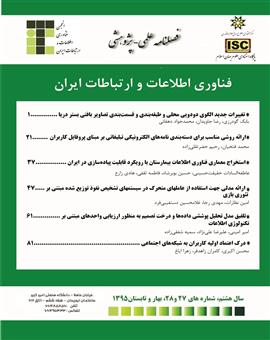استخراج معماری فناوری اطلاعات بیمارستان با رویکرد قابلیت پیاده سازی در ایران
محورهای موضوعی : عمومىحسین بوبرشاد 1 , عاطفه السادات حقیقت حسینی 2 , هادی زارع 3
1 - هیات علمی
2 - دانشجو
3 - -
کلید واژه: بیمارستانهای نسل آینده, معماری فناوری اطلاعات, معماری توگف,
چکیده مقاله :
امروزه ارائه خدمات هوشمند و سریع به بیماران و حرکت به سمت بیمارستانهای نسل آینده، از ضروریات حوزه سلامت است. تهیه معماری اطلاعات برای بیمارستانها مقدمه دستیابی به خدمات هوشمند و به تبع آن ارایه خدمات با سرعت و کیفیت بسیار بالاتر نسبت به سیستمهای سنتی است. در این مقاله هدف ارایه یک معماری اطلاعات بومی مبتنی بر معیارها و شاخصهای مهم در بیمارستانهای ایران بوده است. در این مقاله از معماری فناوری اطلاعات TOGAF استفاده و سپس این معماری متناسب با شرایط بومی ایران برای بیمارستان شریعتی بومی سازی شده است. برای این کار از نظر خبرگان و ابزار پرسشنامه 134 سوالی بهره گرفته شده و بر اساس آزمونهای مناسب آماری مورد تحلیل قرار گرفته است. در این مقاله معماری فناوری اطلاعات در قالب یک مدل مفهومی دارای چهار ورودی و چهار لایه زیرساختی طراحی شد. نتایج نشان داد از میان 134 جزء معماری فناوری اطلاعات توگف، تعداد 104 جزء، توسط خبرگان برای کاربرد در بیمارستان مورد تایید قرار گرفت. این چارچوب اختصاصیسازی شده، معماری فناوری اطلاعات بیمارستان نامیده شد. معماری پیشنهادی که در هشت لایه و یازده جزء ترسیم شد و میتواند به عنوان یک معماری مرجع بومی برای اجرای معماری اطلاعات در بیمارستانهای ایران مورد استفاده قرار گیرد.
Today, providing smart and fast services to patients and moving towards next generation hospitals is one of the necessities of the health field. Preparing information architecture for hospitals is a prelude to obtaining intelligent services and, as a result, providing services with much higher speed and quality than traditional systems. In this article, the aim was to provide a native information architecture based on important criteria and indicators in Iranian hospitals. In this article, TOGAF information technology architecture is used and then this architecture is localized according to the local conditions of Iran for Shariati Hospital. For this purpose, a 134-question questionnaire was used from the experts' point of view and it was analyzed based on appropriate statistical tests. In this article, information technology architecture was designed in the form of a conceptual model with four inputs and four infrastructure layers. The results showed that among the 134 components of TOGF information technology architecture, 104 components were approved by experts for use in the hospital. This customized framework was called Hospital Information Technology Architecture. The proposed architecture was drawn in eight layers and eleven components and can be used as a local reference architecture for the implementation of information architecture in Iranian hospitals.
